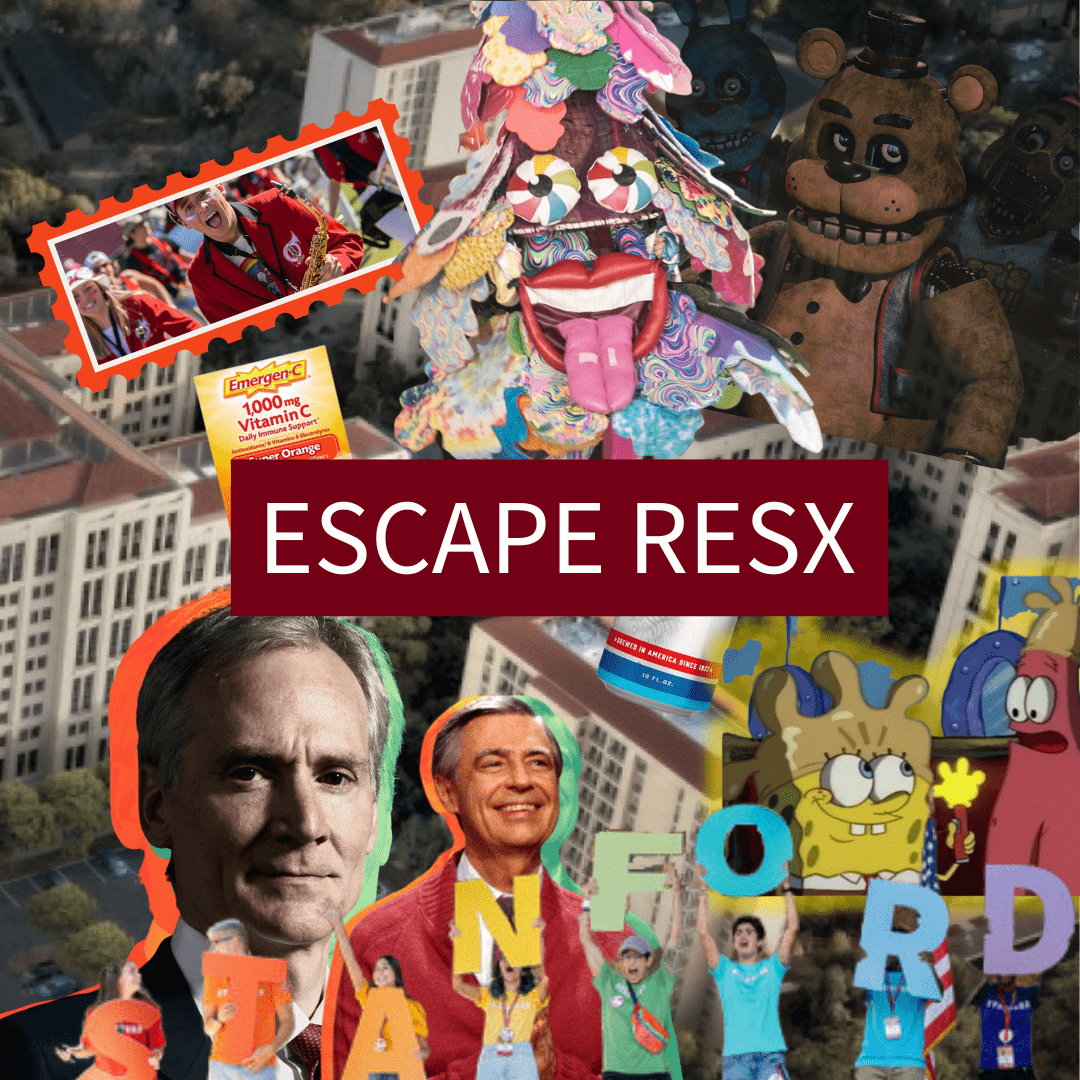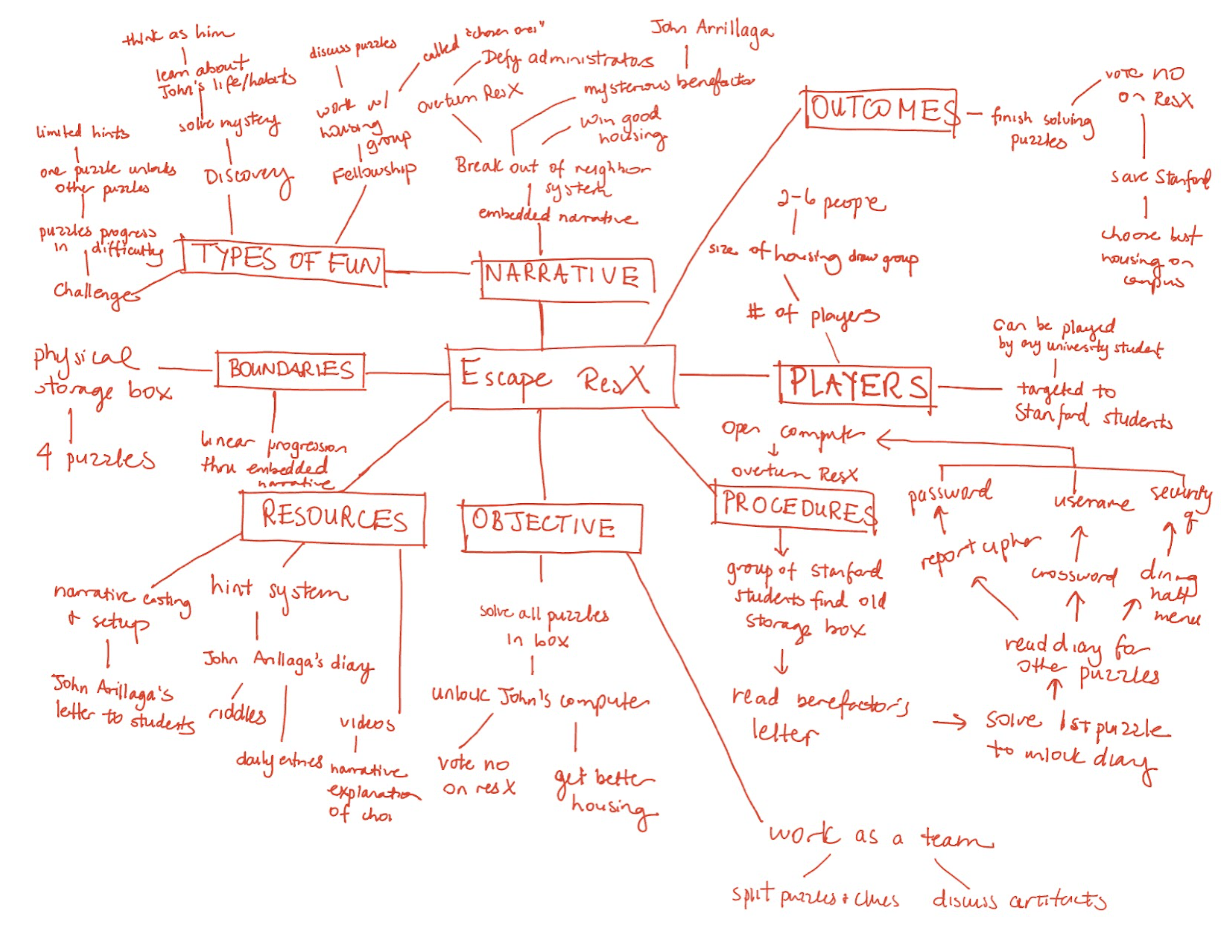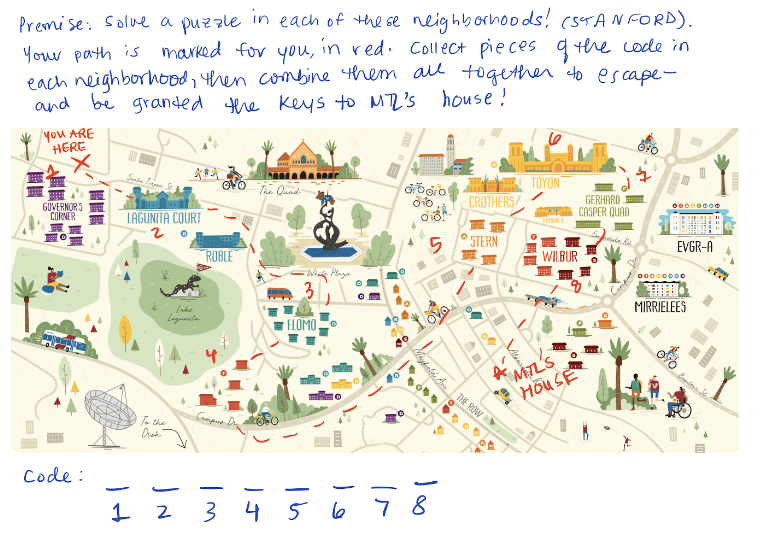
Escape ResX
CS247G – Games in Space Project
Group Members
Sasha Moore
Uma Phatak
Jake Restaino
Drew Silva
Melanie Zhou
Artist’s Statement
As the creators of Escape ResX, we sought to create a game that would resonate with our target audience: fellow Stanford students. We were frustrated by the repressive, arbitrary, and confusing Stanford neighborhood system and thought that students could benefit from a game that gives them agency to choose good housing.
Although the premise of the game is satirical, Escape ResX encourages Challenge, Discovery, and Fellowship. The game is tied together by an embedded narrative of John Arillaga’s final moments in life. Our hope with our escape-room-in-the-box model is that any group of students can stumble upon John Arillaga’s mysterious storage box full of puzzles and become “the chosen ones” who save Stanford from the neighborhood system. As long as they work together and creatively problem-solve, they have a shot at better housing for themselves and their entire community.
The game’s complexity derives from unique puzzles in evocative Stanford artifacts. The fun from the game is that things students see in their daily lives— dining hall menus, reports, crosswords— are now intricate puzzles for them to crack. Nothing is what it seems, and students can only progress through the game by challenging their assumptions, trying different interpretations of clues, and discussing with each other the best way forward.
Ultimately, Escape ResX forces players to literally “think outside the box.” The game is a thrilling and immersive experience that should be fun whether you’re a Stanford student or any university student that has been wronged by your housing system. We believe this escape-room-esque game will keep you on the edge of your seat from start to finish. Good luck!
Print and Play
Enjoy our game for yourselves using these materials!
Gameplay Explanation Using Course Concepts
Figma Flowchart Here (pictured below)

| Design Decision Justifications | |
| Game Progression | The game progresses in an ordered fashion through a series of layers that are controlled by different “locks”. In the first layer, the players have to solve an easy image-based puzzle to unlock the diary. In the second layer, the players have to solve three medium-difficulty puzzles that unlock John Arillaga’s computer. In the third layer, the players have to solve a final hard puzzle using invisible ink and a black light that is accessible only via a locked-box that we give players the code to after getting through the username, password, and security question. They go back to the three puzzles from the previous layer and look at them in a new light. Once they solve that final puzzle, they can cast their vote against ResX and unlock videos from John Arillaga congratulating them.
We decided on this game progression after various levels of playtesting. We realized that different layers of difficulty helped move the game forward and kept the game challenging and rewarding. The complexity of the layers with strong guidance on how to navigate through them helped establish our narrative. Finally this game progression helped with our game-in-a-box format. Playtests revealed that users were overwhelmed looking at a full box of random artifacts. By segmenting artifacts into different levels, we are able to guide players through the chaos and stay focused on the tasks. |
| Game Onboarding | To onboard players, we rely on two main artifacts in the box: the letter and the diary. The letter “casts” the players as Stanford students chosen to escape the neighborhood system and introduces them to the main objectives of the game. The diary serves as a hint system throughout the game, as players reference it to guide them between puzzles and look for different approaches if they need it. Our game onboarding uses the embedded story method because of our game-in-the-box format. This is because we wanted to immediately immerse our players in the game without suspending their belief. Onboarding as narrative also achieves the fun of Discovery in narrative as the players have to figure out for themselves their role and objectives. |
| Use of Space | We chose a game-in-the-box as a way to control our game in space. We ultimately chose this design decision because creating a physical escape room would be difficult when trying to make the game accessible to many players, hard to control game progression and difficulty level, and hard to create narrative cohesion. We wanted the game to be played anywhere, which is the game-in-a-box model. An advantage of the game-in-a-box model is that we can heavily rely on artifacts in the box to tell the narrative of our game, onboard players, and progress the game. We wouldn’t have to create ambience by decorating and designing a physical room space. Because of these reasons, we chose the game-in-the-box format for our game. |
| Use of Narrative | The use of embedded narrative is extremely strong in our game. The entire game is framed through a mysterious benefactor who enlists students to help him overthrow the Stanford neighborhood system. Students discover different aspects of the mysterious benefactor’s life (John Arillaga) while solving the puzzles and are ultimately congratulated by him for completing the puzzles. The narrative is put together by every puzzle in the game, as they emphasize different aspects of his life: his diary, his bird watching hobby, his eating habits, his favorite crossword, and the report that he was reading. We decided to build our game around an embedded narrative after our initial playtest. When we didn’t have a strong embedded narrative, players were unclear on their game objectives and didn’t know their roles. They eventually lost interest in the game because the game-in-the-box method doesn’t allow for direct feedback from the game designers when they had these questions. Through a structured embedded narrative, we were able to properly cast players, confirm their game objectives, and keep them on track with the game without actual intervention. |
| Game Architecture and Core Loops | Our game architecture involves one main interaction loop:
This interaction loop is supplemented by a suggested “golden path” that the diary hints at that gives players an indication of the right order to do the puzzles in order to be successful. We tested this interaction loop for fairness and balance, as well as fun and challenge. From our playtests, we realized that this main interaction loop was the easiest for players to stay on path in the game. Because the puzzles increased in difficulty, the interaction loop did not become tedious or boring either. Over time, the interaction loop became a slow, infrequent loop because of the increase in puzzle difficulty. By the end of the game, players experience “evocative feedback” in the form of videos from John Arillaga congratulating them on solving the puzzle. |
| Tone | The tone of the game is very satirical and humorous. In this imagined Stanford world, we give students agency to earn their own housing and make John Arillaga a quirky guy who left an elaborate plan for students to honor his dying wish. We intend to portray the Stanford administration as exaggerated villains and poke fun at the Stanford neighborhood system and John Arillaga’s omniscient presence on campus buildings as an alumni donor. Our premise humorously contrasts with the often more serious and threatening themes of an average escape room.
We achieve this tone through satirical artifacts that serve narrative purposes, specifically the letter, the diary, and the ending videos. We chose this tone because our playtesters often commented that the game was extremely “clever” and was very relatable to their university lives. This tone made the narrative more believable and was a way to connect with our target audience. |
Concept Map

Concept Iteration 1
In our initial brainstorming, we were interested in developing a game that combined Challenge, Discovery, and Fellowship, that was Stanford-neighborhood themed. Throughout the process, we stayed committed to this target audience: Stanford students. We were interested in creating a satirical version of Stanford where you could “escape the neighborhood system” and win the best housing on campus. Our brainstorms included:
- Type of game: Physical escape room that simulates the EVGR dorm room on Stanford’s campus.
- Narrative:
- Our primary protagonists are friends in a Stanford draw group— friends most likely brought together by their freshman dorm— fighting for their chance at the best housing on campus. These friends will no longer stand for the one room doubles, random roommates, bad dining hall food, and limited row house options brought upon by Stanford’s neighborhood system.
- Players find secret puzzles, which they must solve in order to escape. As the game progresses, they discover that there is a puzzle in each neighborhood that they must solve under immense time pressure to get the chance to choose their own housing for their last year on campus.
- Puzzles:
- A map to unify the escape room
- A puzzle involving randomness
- Crossword
- Digital component: map
- Finding hidden objects / deciphering codes. These are typical escape room puzzles, and contribute to our aesthetic of Challenge.

We thought our uniting component might be something like the above map, with 8 puzzles.
Concept Iteration 2 – Final Iteration
After getting feedback from our CA and doing an initial playtest on our narrative, we realized that our old format had 1) difficulty navigating space in an EVGR room 2) narrative confusion about why we were in an EVGR room 3) too many puzzles that would make the game too long.
With this in mind, we pivoted to an MVP, game-in-the-box format that centers around a mysterious benefactor who enlists students to help him overthrow the Stanford neighborhood system. In this new framing, we were able to preserve our original aesthetics of fun (Discovery, Challenge, and Fellowship) while creating more narrative cohesion and difficulty in puzzles. Our puzzles from our first concept largely remained the same, but we also wanted to incorporate elements of game progression. This is when we created our Figma flowchart from above.
- Type of game: Game-in-a-box model. Stanford students discover a mysterious storage box on the last-day of move out.
- Narrative
- Stanford students discover a mysterious storage box from John Arillaga tasking them to overthrow the Stanford neighborhood system by breaking into John’s laptop and voting no on ResX. Different puzzles unlock different parts of his computer (username, password, security question).
- Artifacts / Puzzles
- Personal diary → Hint system and narrative guide throughout game
- Digital component computer system where John votes no to ResX
- John’s favorite bird pictures → unlocks his personal diary
- Crossword → unlocks username
- Dining hall menu → unlocks security question
- Report cipher → unlocks password
- Videos from John when you open the computer
Below is our intention on how the Mechanics of our game create Dynamics that ultimately create our three desired Aesthetics. In the Gameplay Iteration Log, the history of these Mechanics is explored further.
| Mechanic | Dynamic | Aesthetic |
| Embedded narrative of voting no to the neighborhood system to honor John Arillaga’s dying wish | Players use this narrative as a lens to interpret the puzzles in the box and use it to unify different aspects of the game. | Players feel Discovery uncovering aspects of John’s life through personal artifacts like his letter and diary logs to the players. The narrative helps players feel rooted in a sense of time and place as well. This discovery feels satisfying at the end of the game with videos that John Arillaga leaves for the players |
| Escape room in-a-box with different puzzles | Players try multiple different approaches (receiving feedback from the digital component or lock about their answer). They also rely on a written hint system in the diary to get through roadblocks. | Players feel Challenge trying to solve different puzzles that require them to synthesize multiple different artifacts (diary + puzzle) and question how artifacts they are familiar with (e.g. dining hall menu) could represent new information. |
| First layer of game has one puzzle
Second layer of game has three puzzles Third layer of game has one hard puzzle |
Players identify strengths and weaknesses in the group (who is better at text-based puzzles vs image-based) and split into subgroups that emphasize these strengths in second level of game | Players feel Fellowship because they have to work all together in the first layer of the game. This fellowship strengthens in layer 2 when they have to figure out the smartest way to split their “housing group” in order to do all the puzzles in the box |
Gameplay Iteration Log (Link)
Here is a link to our 12-page iteration log.
Video of Playtest
Here is a video of our third playtest, right before the final (35 mins). And here is a video of our final playtest (25 mins):
Following is a summary of important moments from the final playtest (second video). “Aha” moments are indented.
0:20 – 0:50: Using the birds to get the code “618”
0:50 Unlocking the diary via the birds – cool “aha” moment!
0:50 – 3:50: Reading all the diary entries
3:50 – Finding the papers hidden in the diary – another “aha” moment.
6:00 – 10:00 – Solving the crossword puzzle and unscrambling “enigma”
10:00 – 12:30 – Solving the dining hall menu puzzle
11:18 – Finding the calendar in the diary
13:00 – 14:30: Solving the cipher puzzle
14:30 – 16:00: Plugging into the digital component
15:54: They get into the next screen!
16:00 – 17:00 – Finding the blacklight in the lockbox and figuring out it’s invisible ink
17:00 – 23:45: Scanning all materials for invisible ink (missed the URGENT sign).
24:00 – 24:15: Clicking in the correct order
24:15 – End: Watching the final congrats video 🙂
Future Directions
As stated above, this project is an MVP; we focused on having a complete narrative and puzzle cohesion. With more time and resources, we would be interested in adding one or two more physical puzzles (perhaps some that use the box itself) to up the complexity of the game.




Probably the best game I have ever played! Changed my life!
This game completely changed my perspective on almost everything I hold near and dear to my heart. 10/10 would recommend